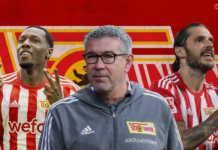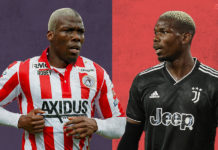
The derby match between Salernitana and Nocerina started strangely. Played in the third tier of Italian football, the match saw three Nocerina substitutions after just three minutes. Soon, another Nocerina player went down injured and had to come off. As no more substitutes were allowed, the team played on with one fewer player.
This situation continued another four times. Five different Nocerina players seemed to suffer serious injuries and were also escorted off the pitch. Under the rules of football, no game can continue when one team has six players or fewer. Consequently, the referee abandoned the match after 20 minutes.
It was a farcial end to a bizarre day. As a local derby between long-term rivals from the Campania region, this game was flagged by authorities as one with extra potential for disorder, and away (Nocerina) fans were thus banned from travelling to the match.
Incensed by the decision, the fans declared that, if they couldn’t watch the game, then it shouldn’t go ahead at all. The kick off was delayed because protesting Nocerina ultras (hardcore fans) held up their team bus and allegedly issued death threats to their own side (an allegation since denied by the ultras). Whatever the truth, Nocerina players were understandably reluctant to play the game.
Much of the media and political focus has centred on the death threatsand their approach to the players. But to understand the events in Salerno it is important to recognise the role of the ultras and how they were able to assert these threats; actions that led to the players forfeiting the match.
So how has Italy ended up in a situation where players fear their own fans?
From fans to protest movement
Ultras groups are extremely passionate fans who have an intense loyalty to their club and their hometown. They display this love through choreographed banners, flags, chants, and in some cases, pyrotechnics. They are predominantly young men who hail from the locale.
These groups began in Italy in the late 1960s, growing out of organised supporters clubs that were established as meeting points for fans. The particular historical and political culture of Italy has had a huge influence on their development.
From the massive strikes of 1969’s “hot autumn”, and continuing throughout the 1970s, Italian society was highly politicised. Protests in piazzas across the peninsular challenged the political status quo. Political terrorism emerged, culminating in the abduction and assassination of former prime minister, Aldo Moro, by the Red Brigades in 1978.
The ultras grew in this climate. Fans took the banners and flags from the piazzas to the stadiums. They took similar names to political groups – Bologna ultras, for instance, called themselves the “Red and Blue Commandos”. More significantly, these groups reflected the traditional political climate of their region. Ultras from Bologna and Genoa, for example, broadly followed a left-wing ideology. In the more conservative region of Veneto, fans of Verona were broadly right-wing.
Extreme localism also needs to be factored into the ultras’ culture. Historical local traditions remain strong in Italy, and have not been superseded by national ones. This emotional attachment is called campanilismo and refers literally to the love of one’s own local bell-tower (campanile).
These local and political factors help structure rivalries with other fans. Consequently derby matches, such as the one between Salernita and Nocerina, become hotly contested affairs for local pride.
Changing face
The ultras began to fragment in the 1980s and focus on violence, often inspired by English hooligans. Names changed from the political ones of the 1970s. Juventus ultras, for example, called themselves the Drughi after the ultraviolent Droogs in A Clockwork Orange.
As some ultras shifted to violence, the state sought to clamp down. More police were sent into stadiums – even today a wall of riot police greets Italian fans when they attend matches. With a greater police presence, the political dimension changed, and ultras began to focus their attention on the police. Graffiti and slogans declared “ACAB” (“all cops are bastards”).
In Italy, the economic transformation of football was instigated by Silvio Berlusconi, the owner of AC Milan, media mogul, and now former prime minister. Berlusconi played a significant role in implementing the Champions League as well as instigating greater commercial sponsorship and television revenue in Italian football.
These commercial changes re-politicised the ultras in a different way. Ultras started to join together to resist the changes; they perceived that the commercialisation of football challenged their position as the authentic voice of football fandom.
In the 1990s, ultras of all clubs started displaying banners declaring “No al calcio moderno” (“No to modern football”). The political aspect of the ultras remained, but shifted to new forms of protest. This also brought them into conflict with the police (again) and the authorities.
The economic changes to football also reconnected the fans to their locality. Players moved around more and teams became more cosmopolitan, but this led to abuse from the ultras as they reinforced their local roots.
From the 1980s racism became more prevalent in the stadiums of Italy. Abuse was also directed at people from the south of Italy, especially as a result of the Maradona-inspired success of Napoli, league champions in 1987 and 1990. Ultras from clubs in the north displayed banners hoping that Vesuvius or Etna would erupt and destroy southern cities, while graffiti welcomed southern fans to “Italy” (the south being portrayed as Africa).
Racism and regional abuse led to further conflict in 2013 when a series of clubs whose fans indulged in racist and “territorial discrimination” had their stadiums, or terraces, closed. This, however, simply reinforced the ultras’ mentality. Fans of rival clubs came together to challenge the authorities, seeking to reassert their power and their role as the true voice of football fandom.
New insiders
Unlike fans in Germany who remain part-owners of their clubs, Italian fans have no ownership rights. Despite this, the ultras have been incorporated into the patrimonial culture within Italian football. Owners realised that empty stadiums were bad for business and welcomed the passionate choreographed crowd displays that the ultras brought.
Many owners provided free tickets to leading ultras to ensure that stadiums had atmosphere. In return, ultras provided banners, ticker-tape, and support. In some cases, the ultras would provide a service to the owner. As Gianluca Vialli has pointed out, when an owner wanted to remove a manger he would ask the ultras to start chanting against him. The negative atmosphere thus legitimises the owners eventual decision.
Ultras felt their power within clubs increasing and started to defend their privileges. Lazio’s ultras, the irriducibili, had the merchandising rights for the football club, as well as receiving free tickets. When owner Claudio Lotito attempted to remove these privileges, bombs were sent to the offices of the club.
It is this same privilege of power that allowed Nocerina fans to threaten their own players. Ultras see themselves as the authentic voice of football fandom, in the face of commercial and political changes to football. But they are also the product of a highly politicised and localised football culture which has a tradition of mobilisation, but wants to reassert identity and pride through football.
The greater migration of players has led to ultras seeing players as mercenaries who don’t have the same love of the club as they do. Nocerina ultras wanted to reinforce this sense of local pride on the players; to disastrous effect.




